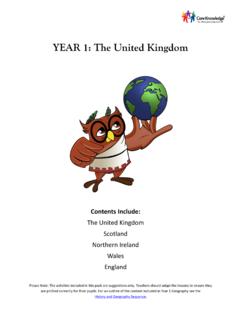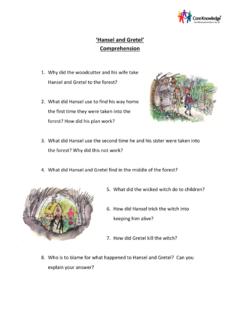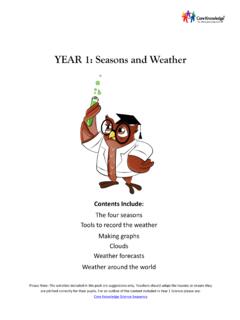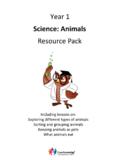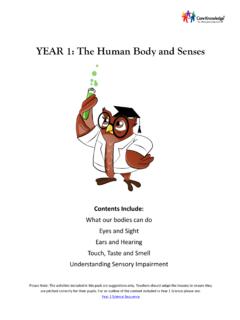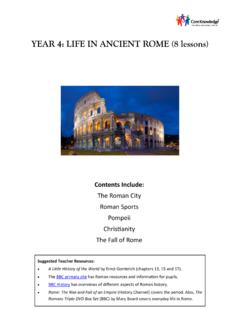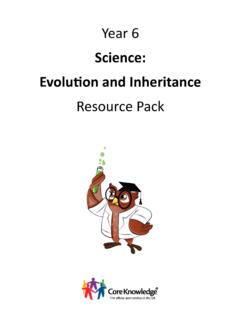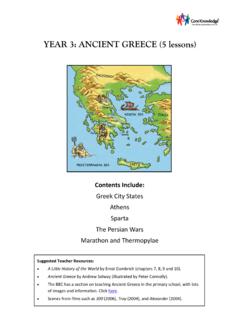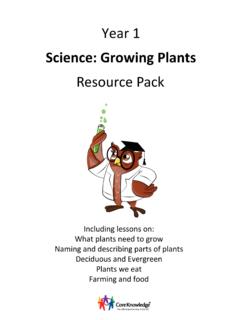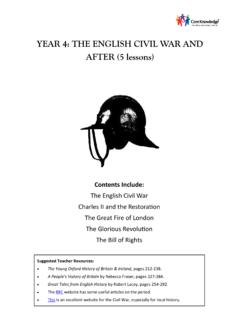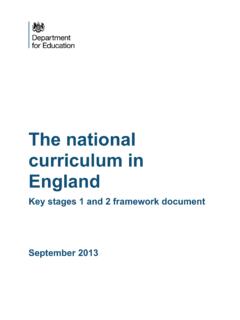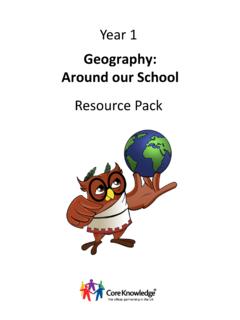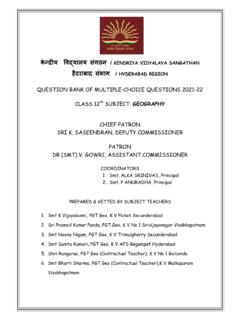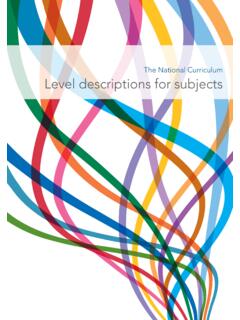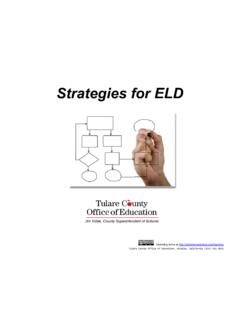Transcription of YEAR 1: The Seven Continents - Core Knowledge UK
1 YEAR 1: The Seven Continents Contents Include: Europe Antarctica Asia Africa North and South America Australia Please Note: The activities included in this pack are suggestions only. Teachers should adapt the lessons to ensure they are pitched correctly for their pupils. For an outline of the content included in Year 1 geography please see: History and geography SequenceLesson 1: The Seven Continents This lesson is the first in a series of lessons that introduce children to the Seven Continents . During this lesson children should begin to understand that Continents are very large areas of land. This may be a difficult concept for young children to grasp, but foundations can be laid for future understanding. The lesson should include lots of images, models and video where appropriate. Children should have some experience of simple maps from previous units of work. A globe can be introduced at this stage as a map made into the shape of Earth. There are Seven Continents on Earth: Asia, Europe, Africa, North America, South America, Australia and Antarctica.
2 There are five oceans on Earth: The Pacific Ocean, The Atlantic Ocean, The Indian Ocean, The Southern Ocean and the Arctic Ocean. See page 120 of What Your Year 1 Child Needs to Know Learning Objective core Knowledge Activities for Learning Related Vocabulary Assessment Questions To begin to recognise Continents and oceans. A globe shows where there is land and sea on Earth. A continent is a large area of land. There are Seven Continents on Earth. Prior learning assessment: Ask children to label a blank map of the world with the names of Continents or any other information they already know. Ensure children know it is just a check on what they already know and that it is fine to leave the page blank if they don t know anything yet. Using a globe, show children the land masses and the seas. Label a large map of the world on the whiteboard asking children to repeat the names of the Continents . Explain that a continent is a large area of land. Show children images of animals, people and places from each continent.
3 Create a passport or information book that children will add to during each lesson of this unit. A labelled outline of the Continents could be used as a front cover. This could be drawn by the children, traced or an outline could be provided for labelling. Children could write letters to relevant embassies or organisations to ask questions about specific countries. They may receive some interesting responses. Earth Globe Asia Europe Africa North America South America Australia Antarctica Pacific Atlantic Indian Southern Arctic What can you tell me about this globe? What can you tell me about this world map? What is a continent? Do you know the names of any of the world s oceans? Resources: Video of children singing the names of the Continents to the tune of Fr re Jacques. BBC Class Clip - Climate zones across the world Interactive Map - National Geographic Google Earth is a fantastic interactive resource to show children the Earth 12 Lesson 2: Europe In this lesson children will learn about the continent of Europe.
4 The most important thing for children to understand is that we live in Europe. The continent of Europe is one of the smaller Continents on Earth. It is bordered by the Mediterranean Sea to the south and the Atlantic Ocean to the west and north. A border with Asia lies to the east of Europe. Within the continent of Europe there are many cities such as Paris, Rome and London. In some parts of Europe the weather can be warm and sunny in the summer, particularly along the Mediterranean coast. In other more northern parts of Europe, the climate is cooler and winters can be cold and snowy. Animal habitats in Europe have largely been influenced by humans and there are few areas of natural wilderness compared to some of the larger Continents . See page 125 of What Your Year 1 Child Needs to Know Learning Objective core Knowledge Activities for Learning Related Vocabulary Assessment Questions To recognise the continent of Europe. We live in the continent of Europe.
5 Europe is one of the world s smaller Continents . In southern Europe the climate can be warm and sunny, but in northern Europe the climate is cooler. Extension: Mammals that live in Europe include badgers, bats and hedgehogs. Recap previous learning asking children to explain what they know so far about Continents . Explain that we live in the continent of Europe. Identify Europe on a globe and on a map of the world. Identify the Atlantic Ocean. Discuss why the northern areas of Europe are cooler than the southern areas. Identify some of the countries located within Europe, particularly those with specific relevance to the members of your class. Identify some key physical and human features of Europe such as the shape of Italy, a peninsula that forms the shape of a boot. Identify different landscape in Europe such as the Alpine Mountains and the flat Northern European plains. Label a map of Europe with relevant place names or illustrations. Find out about European animals and their habitats.
6 Continent Europe Antarctica climate ocean border North South East West mountain plain Where is Europe on this map/globe? What can you tell me about Europe? How is northern Europe different to southern Europe? What animals can be found in Europe? Can you describe a European animal and the habitat within which it lives? Resources: European Wildlife - A Pan-European non-profit organization dedicated to nature conservation and landscape protection. Teacher subject Knowledge : European Physical geography from National Geographic Education. Rewilding Europe A movement to re-establish areas of wilderness in Europe gallery contains some beautiful images. 3 Europe 4 Badger Meles meles Badgers live underground in setts. They eat small animals, plant roots and fruit. Badgers are nocturnal. Bat Common Noctule - Nyctalus noctula Bats are the only mammals that can fly for a long time. They mostly live in forests. They eat insects. Hedgehog Erinaceus europaeus Hedgehogs are nocturnal.
7 They live in hedgerows and gardens. They eat slugs, worms, beetles and other insects. Mallard Anas platyrhynchos Mallards, or wild ducks, live in wetlands and eat plants and small animals. Male mallards have glossy green heads but females are mainly brown. Adder Vipera berus Adders live in different habitats including meadows and hedgerows. They eat small animals. They are venomous snakes, but their bites would not normally kill a human. Toad Bufo bufo Toads often live in forests or fields, not always near water. They walk slowly or jump using all four legs. Toads eat woodlice, slugs, beetles and swallow their food whole. European Animals 5 Eiffel Tower Eurotunnel Leaning Tower of Pisa Alpine Mountains The Rhine Woodland Human and Physical Features of Europe The Eiffel Tower is in France. The Eurotunnel runs between France and England. The Leaning Tower of Pisa is in Italy. The Alpine mountain range stretches across eight countries in Europe.
8 The Rhine is a river that runs through Germany and two other countries in Europe. A long time ago Europe was covered in woodland. A quarter of Europe is now woodland. 6 Lesson 3: Antarctica Antarctica is the world s southernmost continent. The word Antarctica comes from a Greek word meaning opposite the north . Antarctica is a very cold continent and although there are some people temporarily living there for research, nobody lives there permanently. There is a post office on Antarctica, but letters can take up to six weeks to be delivered. Antarctica is home to penguins, seals and other animals that are suited to very cold climates. The coldest temperature ever recorded on Earth was in Antarctica and was recorded by a satellite at degrees Celsius. The geographic South Pole is located in Antarctica. The explorer, Roald Amundsen, was the first person to reach the South Pole in 1911. See page 133 of What Your Year 1 Child Needs to KnowLearning Objective core Knowledge Activities for Learning Related Vocabulary Assessment Questions To recognise the continent of Antarctica.
9 Antarctica is the southernmost continent on Earth. The continent of Antarctica is very cold and icy. There are very few plants and animals living in Antarctica because it is so cold. Recap previous learning and ensure children understand that a continent is a large area of land. Ensure children are able to identify the North and South Poles. Explain that the most southern continent is called Antarctica. Locate Antarctica on a globe and a world map and discuss how its location is the reason why it is so cold. Show children images or video clips of Antarctica. Discuss what children would see/feel/hear if they went there. Using a globe, show children that the Earth s tilt results in Antarctica having a sunny summertime for half of the year, but then a dark winter for the other half of the year. Even though the Earth is orbiting the sun and revolving, its tilt remains the same. This causes Antarctica to face the sun for half of the year, but face away during the other half of the year.
10 Find out about animals that can be found in Antarctica. The land is often colder than the sea, so more life can be found in the icy waters surrounding the continent. Some very small plants grow in Antarctica, but there are no trees or shrubs. North Pole South Pole Antarctica tilt orbit summer winter minus (in relation to degrees) Can you locate Antarctica on this map/globe? What can you tell me about Antarctica? What can you tell me about the seasons in Antarctica? What can you tell me about plants and animals in Antarctica? Resources: The coldest place on Earth - BBC News and Discovering Antarctica from the British Antarctic Survey National Geographic photographer Paul Nicklen meets a leopard seal- check for suitability- play from 24 seconds. Penguin Post Office - BBC Two Natural World 7 Antarctica 8 Leopard Seal Hydrurga leptonyx Leopard seals are the largest seals in Antarctica. They have black spots on their necks. They eat fish, penguins and other seals.
